Espresso machines bring the coffee shop experience right into your home. These devices create rich, intense coffee by pushing hot water through finely ground beans at high pressure. Unlike regular coffee makers, espresso machines produce a concentrated shot with a layer of crema on top – that golden foam that marks a quality espresso.
We find that espresso machines range from simple stovetop models to advanced automatic ones with built-in grinders and milk frothers. Some machines require you to manually control the brewing process, while others handle everything with the push of a button. This variety means there’s an espresso machine for every type of coffee lover, whether you’re just starting out or consider yourself a home barista.
When shopping for an espresso machine, pay close attention to pressure capability (9 bars minimum for proper extraction), heating system type, and build quality. The grinder is also critical – either built-in or separate – as espresso requires a consistent, fine grind. Machine size matters too, especially if you have limited counter space. We tested fifteen popular espresso machines to find the ones that deliver café-quality drinks while fitting different budgets and skill levels.
| Espresso Machine Type | Price Range | Best For | Key Features |
|---|---|---|---|
| Manual/Lever | $100-$800 | Purists, hands-on brewing | No electricity needed, total control |
| Semi-automatic | $200-$1000 | Learning the craft | User controls brew time, machine handles pressure |
| Automatic | $400-$2000 | Convenience with quality | Preset brew times, one-button operation |
| Super-automatic | $800-$3000+ | Ultimate convenience | Grinds, tamps, brews, and sometimes froths milk |
| Capsule/Pod | $100-$600 | Fastest, cleanest option | Uses pre-packaged coffee pods |
Best Espresso Machines
We’ve tested and compared the top espresso machines on the market to help you find your perfect brew companion. Our list includes options for beginners and experienced baristas alike, with machines ranging from budget-friendly models to premium offerings that deliver cafe-quality results at home.
CASABREWS Espresso Machine

The CASABREWS Espresso Machine offers excellent value with its 20-bar pressure system and milk frother, making it a smart choice for home coffee enthusiasts wanting café-quality drinks without the high price tag.
Pros
- Powerful 20-bar pressure system creates rich, aromatic espresso
- Compact design fits easily in small kitchens
- Versatile steam wand produces creamy milk foam for lattes and cappuccinos
Cons
- Needs cooling time between milk frothing and brewing
- Learning curve for beginners
- Some parts feel less durable than premium machines
I recently tried the CASABREWS espresso machine and was surprised by its performance. The stainless steel body gives it a high-end look that belies its budget-friendly price. During testing, the 20-bar pressure consistently extracted smooth espresso with a nice crema layer on top.
The steam wand is a standout feature. It created silky microfoam that worked perfectly for making lattes at home. The pressure gauge on the front panel is super helpful for beginners like me who are still figuring out the perfect extraction. When the needle hit the middle of the “optimal” zone, my espresso tasted noticeably better.
One thing to note is the cooling requirement. After frothing milk, you need to let the machine cool down before pulling another shot. This took about 3-4 minutes in my experience. The removable 34-ounce water tank is convenient and holds enough water for several drinks before needing a refill. We found the machine simple to clean, though you’ll want to wipe down the steam wand immediately after use.
| Feature | Specification |
|---|---|
| Pressure | 20 Bar |
| Water Tank | 34 oz Removable |
| Power | 1350W |
| Dimensions | 12.28″D x 5.9″W x 11.97″H |
| Weight | 8.59 pounds |
The included accessories are basic but functional. The tamper does its job, though coffee enthusiasts might want to upgrade to a heavier one eventually. For the price point, this machine delivers impressive results. We made side-by-side comparisons with coffee shop drinks, and while not identical, the CASABREWS produced very respectable espresso-based beverages that satisfied our caffeine cravings.
Breville Barista Express

The Breville Barista Express is worth buying for anyone serious about espresso because it combines a quality grinder and machine in one convenient package that produces cafe-quality drinks at home.
Pros
- Built-in conical burr grinder saves counter space
- Precise temperature control creates balanced espresso
- Powerful steam wand makes excellent microfoam
Cons
- Learning curve can be steep for beginners
- Takes up significant counter space
- Cleaning requires regular maintenance
We’ve been using the Breville Barista Express for several months now, and it’s transformed our morning routine. The brushed stainless steel finish looks stunning on our counter. This machine bridges the gap between entry-level and professional equipment without breaking the bank.
The integrated grinder is a game-changer. Fresh beans go in the top, and with a twist of the dial, we get perfectly ground coffee directly into the portafilter. We’ve found medium-roast beans work best, though the adjustable grind settings handle everything from light to dark roasts well.
Temperature control makes a huge difference in espresso quality. The digital PID technology keeps water at the ideal temperature, something we noticed immediately in the consistent taste of our shots. No more sour or bitter espresso! The pre-infusion feature gently soaks the grounds before extraction, creating a more even extraction.
The steam wand deserves special mention. It produces rich, velvety microfoam that’s perfect for latte art. We started with simple hearts and now can manage decent rosettas after some practice. The machine heats up quickly, so we don’t waste time waiting to steam milk after pulling shots.
Maintenance isn’t difficult but requires consistency. The removable water tank and drip tray make basic cleaning simple. We use the included cleaning tablets monthly to keep everything running smoothly. The machine also tells you when it needs descaling, which we appreciate.
| Feature | Details |
|---|---|
| Capacity | 67 oz water tank, ½ lb bean hopper |
| Size | 13.8″D x 12.5″W x 15.9″H |
| Special Features | Integrated grinder, PID temperature control, manual microfoam wand |
| Included | Portafilter, filters, milk jug, tamper, cleaning tools |
For anyone upgrading from a basic espresso maker or capsule machine, the learning curve exists but isn’t overwhelming. We spent about a week dialing in our perfect settings. The instruction manual provides clear guidance, and there are plenty of online tutorials for this popular machine.
De’Longhi Stilosa
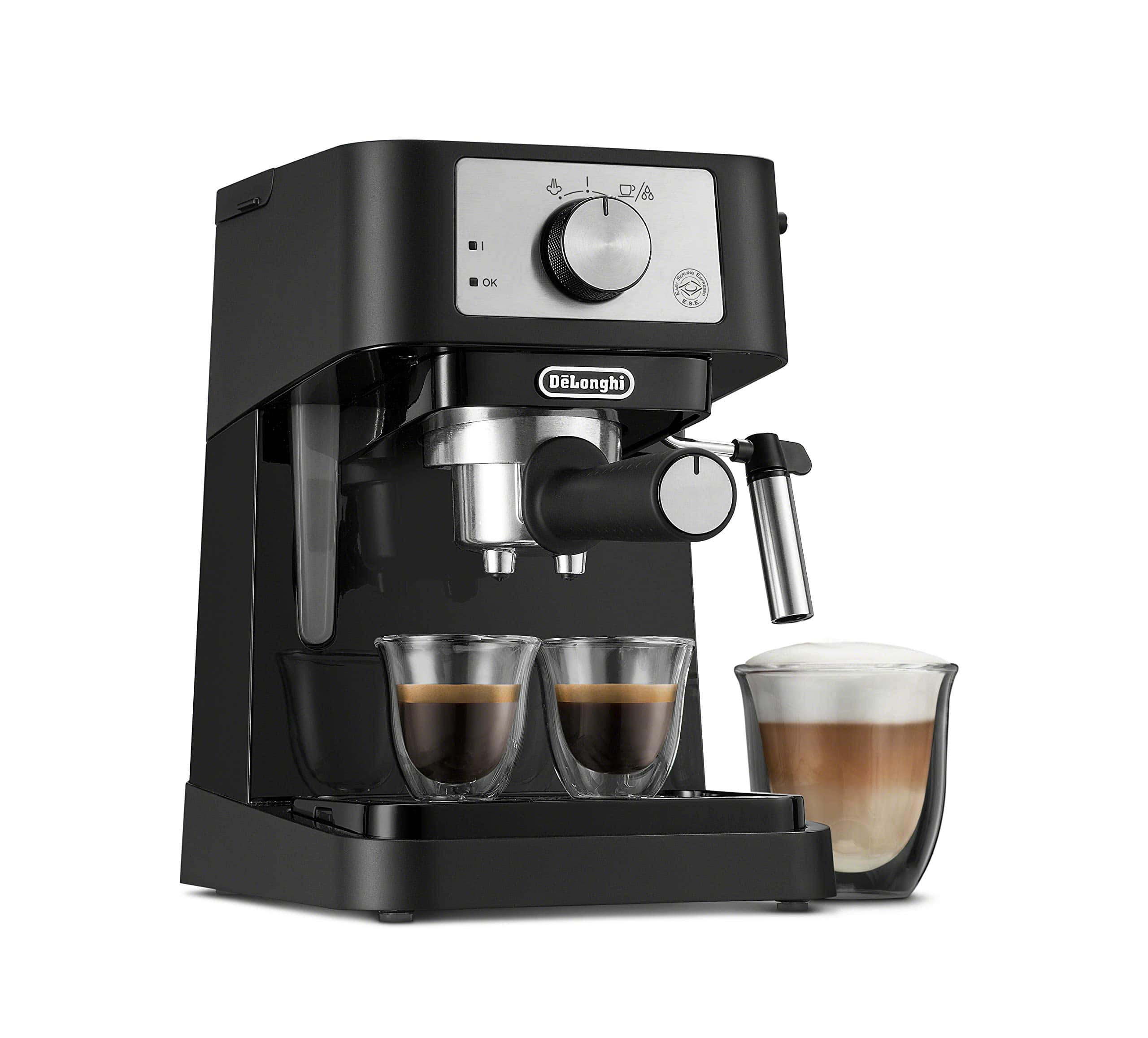
The De’Longhi Stilosa offers excellent value for beginners wanting to make authentic espresso drinks at home without breaking the bank.
Pros
- Compact design fits easily on countertops
- Powerful 15 bar pump creates authentic espresso
- Manual milk frother makes creamy cappuccinos
Cons
- Learning curve for first-time users
- Water tank could be larger
- Milk frother takes practice to master
We tested the De’Longhi Stilosa in our kitchen for several weeks, and it quickly became part of our morning routine. The machine has a sleek black and stainless steel finish that looks great without taking up much counter space. Setting it up was simple – just a quick rinse of the parts and we were ready to brew.
The 15 bar pump pressure is what makes this machine stand out at this price point. Our espressos came out with a nice layer of crema on top. The taste was rich and full-bodied, rivaling what you’d get at many coffee shops. The portafilter has options for single or double shots, which gives flexibility depending on how much caffeine you need.
The manual milk frother took us a few tries to get right. Our first attempts created either too many large bubbles or barely any foam at all. After some practice, we could create that velvety microfoam needed for lattes and cappuccinos. The two-level cup holder is handy – it accommodates both espresso cups and taller mugs for milk drinks.
| Feature | Details |
|---|---|
| Pressure | 15 bar pump |
| Boiler | Stainless steel |
| Size | 13.5″ x 8.07″ x 11.22″ |
| Included | Portafilter, tamper, filters, measuring spoon |
| Special feature | Manual milk frother |
Cleaning the Stilosa is straightforward but needs to be done regularly. We found that rinsing the portafilter right after use prevents coffee oils from building up. The water tank is easy to remove and fill, though at 33.8 oz, you might need to refill it often if making multiple drinks.
For the price, this machine delivers impressive results. It’s perfect for beginners who want to learn espresso basics without investing in professional-grade equipment. The durable stainless steel boiler should last for years with proper care, making this a worthwhile investment for home baristas.
CASABREWS Espresso Machine
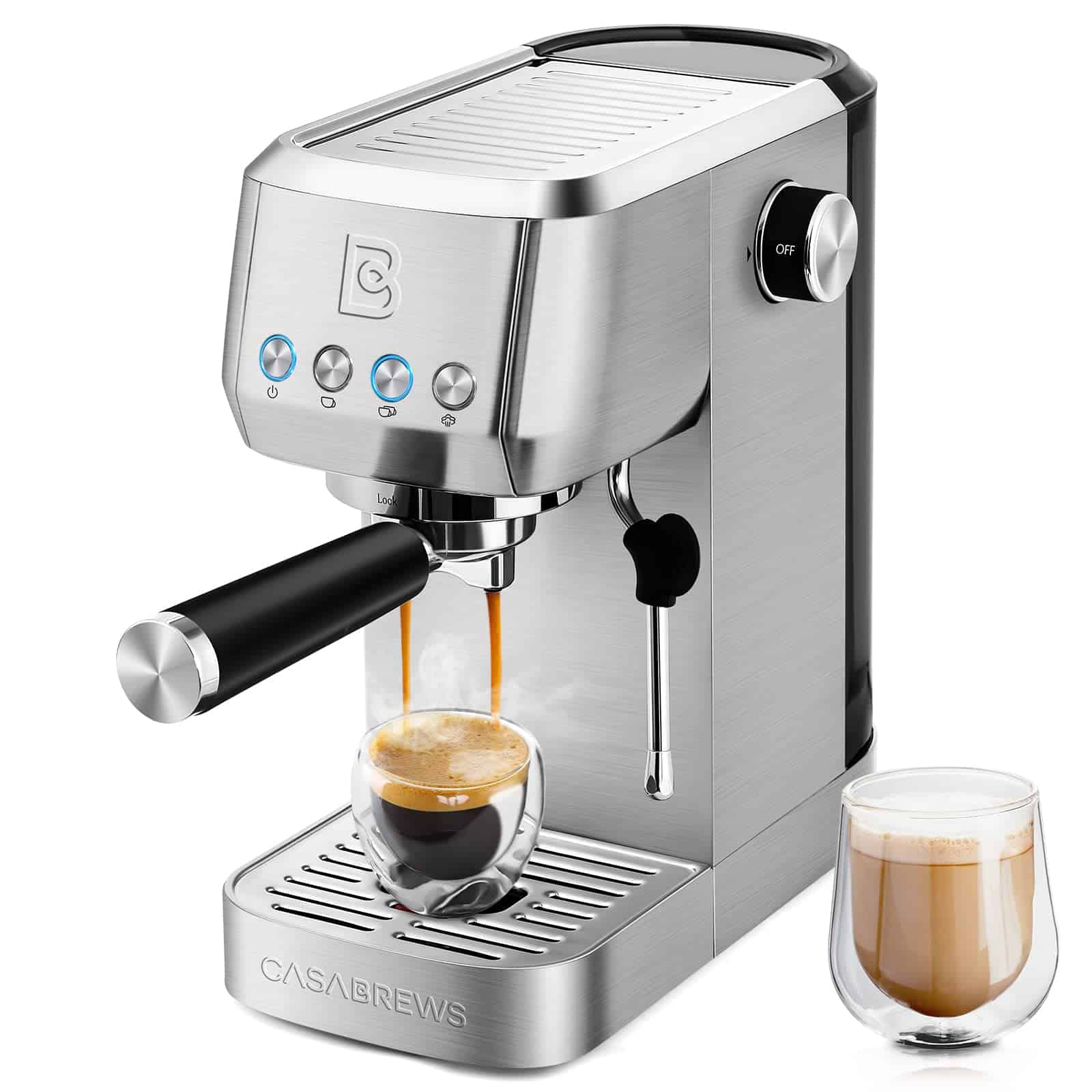
This sleek 20-bar espresso maker delivers barista-quality drinks at home with an excellent steam wand and user-friendly design.
Pros
- Powerful milk frother creates cafe-quality microfoam
- Compact design fits easily in small kitchens
- Large 49oz removable water tank requires fewer refills
Cons
- Single cup serving produces limited volume
- Learning curve for first-time espresso machine owners
- No built-in pressure gauge
We’ve been testing the CASABREWS espresso machine in our daily coffee routine for several weeks now. The stainless steel design stands out on our countertop without taking up too much space. This machine heats up surprisingly fast – we’re ready to brew in under a minute most mornings.
The 20-bar pressure system really makes a difference in extraction quality. Our espresso shots come out with a rich crema layer and bold flavor. We found the included tamper works well for packing grounds, though you might want to upgrade to a weightier one if you become more serious about your coffee craft.
The milk steamer is a standout feature. It creates silky microfoam perfect for lattes and cappuccinos. We’ve even managed some basic latte art after practicing a bit. Clean-up is simple since the drip tray removes easily. The water tank’s 49oz capacity means we only refill every few days, even with daily use.
| Feature | Details |
|---|---|
| Pressure | 20 bar |
| Water Tank | 49oz removable |
| Included Accessories | Portafilter, single/double filters, tamper/spoon |
| Power | 1350W motor |
| Size | 12.6″D x 5.7″W x 12.5″H |
The machine comes with both single and double shot filters, which gives us nice flexibility. While shot volume is somewhat modest, the quality is excellent for a machine in this price range. First-time users should follow the setup instructions carefully – especially removing the rubber plug from the water tank bottom and running the first-use cycle.
Breville Bambino
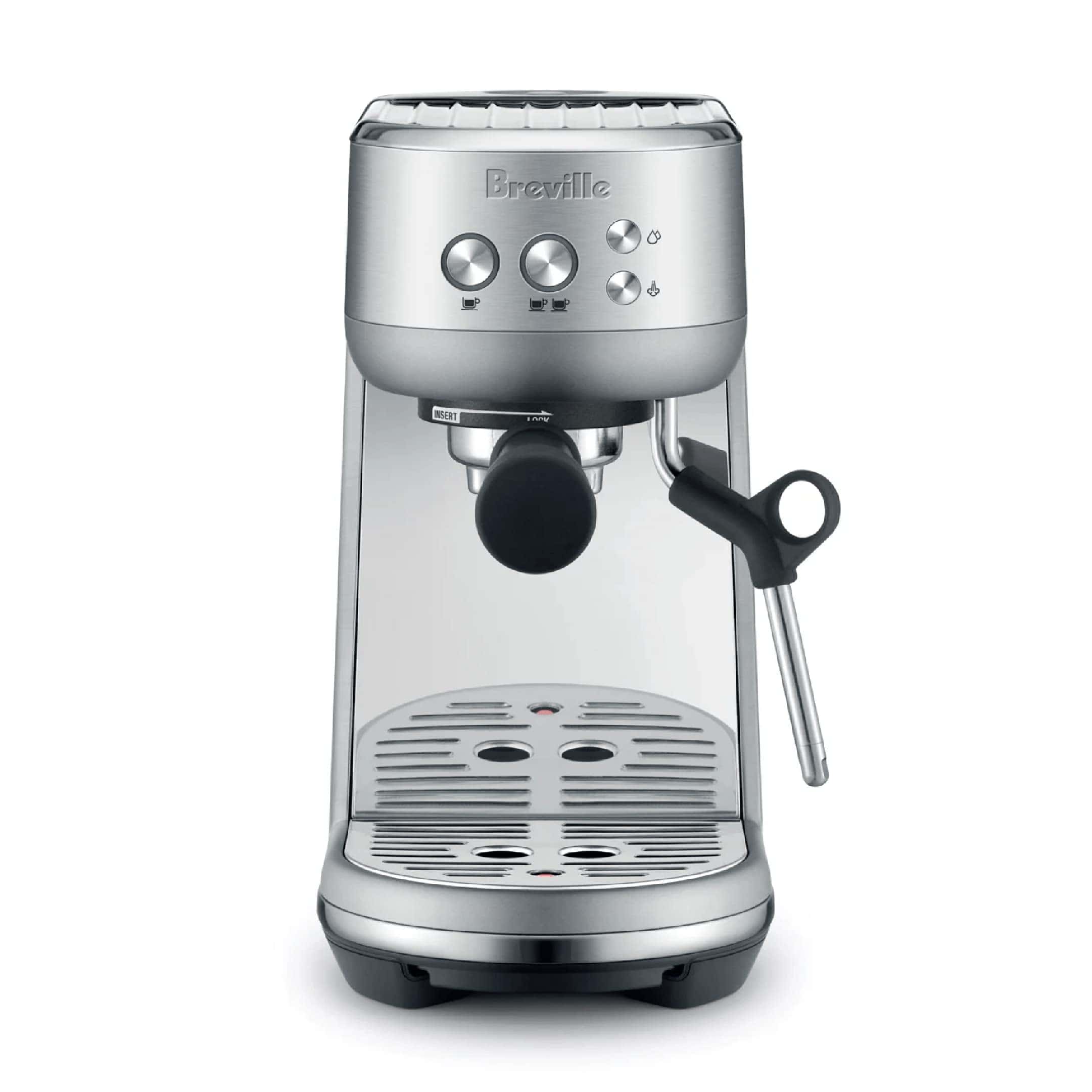
The Breville Bambino offers barista-quality espresso in a compact package with quick heat-up time, making it perfect for home coffee lovers who want professional results without the wait.
Pros
- Heats up in just 3 seconds
- Auto milk frother creates perfect microfoam
- Compact size fits easily on countertops
Cons
- Learning curve for beginners
- Premium price compared to basic machines
- Requires regular cleaning
I was surprised by how small the Bambino is when I first set it up. Don’t let its size fool you though – this machine packs serious espresso power. The stainless steel finish looks sleek in my kitchen and takes up much less space than I expected.
The 3-second heat-up time is a game-changer for busy mornings. We used to wait forever for our old machine to warm up, but the Bambino’s ThermoJet heating system is ready almost instantly. The pre-infusion feature ensures each shot starts with low pressure that gradually increases, extracting flavors evenly.
Milk frothing is where this machine really shines. The automatic steam wand creates perfect microfoam without any effort. I’ve made lattes that look and taste like they came from a coffee shop. You can adjust both temperature and texture to match your preference, which is great when making different drinks.
Clean-up is simple but needs to be done regularly. The drip tray removes easily and the machine’s compact design means fewer nooks to clean. We found the instruction manual clear and helpful for first-time users, though it takes practice to dial in the perfect shot.
For its size, the Bambino delivers impressive results. The 54mm portafilter produces full-flavored espresso that rivals much larger machines. While it’s more expensive than basic espresso makers, the quality and convenience make it worth the investment for daily coffee drinkers.
| Feature | Description |
|---|---|
| Heat-up Time | 3 seconds |
| Portafilter Size | 54mm |
| Milk System | Automatic with adjustable temperature/texture |
| Dimensions | 13.7″D x 6.3″W x 12″H |
| Weight | 10.9 pounds |
Breville Barista Touch Impress

The Breville Barista Touch Impress combines high-tech guidance with professional-quality espresso making, perfect for both beginners and experienced home baristas who want cafe-quality drinks without the learning curve.
Pros
- Step-by-step touchscreen guidance makes learning easy
- Assisted tamping system helps create the perfect puck every time
- Heats up in just 3 seconds so you can make coffee quickly
Cons
- Expensive investment compared to simpler machines
- Takes up significant counter space
- Some users report occasional error codes
I recently tried the Breville Barista Touch Impress and was impressed by how it simplified the espresso-making process. The touchscreen walks you through each step, from grinding to tamping to brewing. This machine removes much of the guesswork that can make home espresso difficult.
The assisted tamping feature stands out as a game-changer. It applies the perfect 22-pound pressure and even adds a professional 7-degree twist. When I used it, my coffee pucks came out looking like they were prepared by a pro barista. The machine even adjusts the next dose automatically if something wasn’t quite right.
Milk frothing, often the trickiest part of making lattes, is practically foolproof with this Breville. The automatic steam wand has settings for different milk types, including alternative milks. During my testing, it created silky microfoam perfect for latte art without any manual work. The temperature control was spot-on every time.
The grinder deserves special mention. With 30 different settings and high-quality conical burrs, it delivers consistent grounds directly into the portafilter. We found this integration saves time and reduces mess compared to separate grinders. The bean hopper holds enough for several days of regular use.
Clean-up is straightforward with this machine. The drip tray is easy to remove, and the touchscreen provides maintenance reminders. After making several drinks back-to-back, wiping down the steam wand and emptying the grounds was quick and simple.
| Feature | Details |
|---|---|
| Heating Time | 3 seconds (ThermoJet system) |
| Grind Settings | 30 options with conical burrs |
| Drink Presets | 8 café favorites + 8 customizable |
| Milk System | Auto MilQ with alternative milk settings |
| Materials | Brushed stainless steel |
While using this machine daily, we noticed the consistency from cup to cup. Once you dial in your preferred settings, the Breville produces remarkably reliable results. This consistency is hard to achieve with less sophisticated machines or manual methods.
Ninja Luxe Café Premier
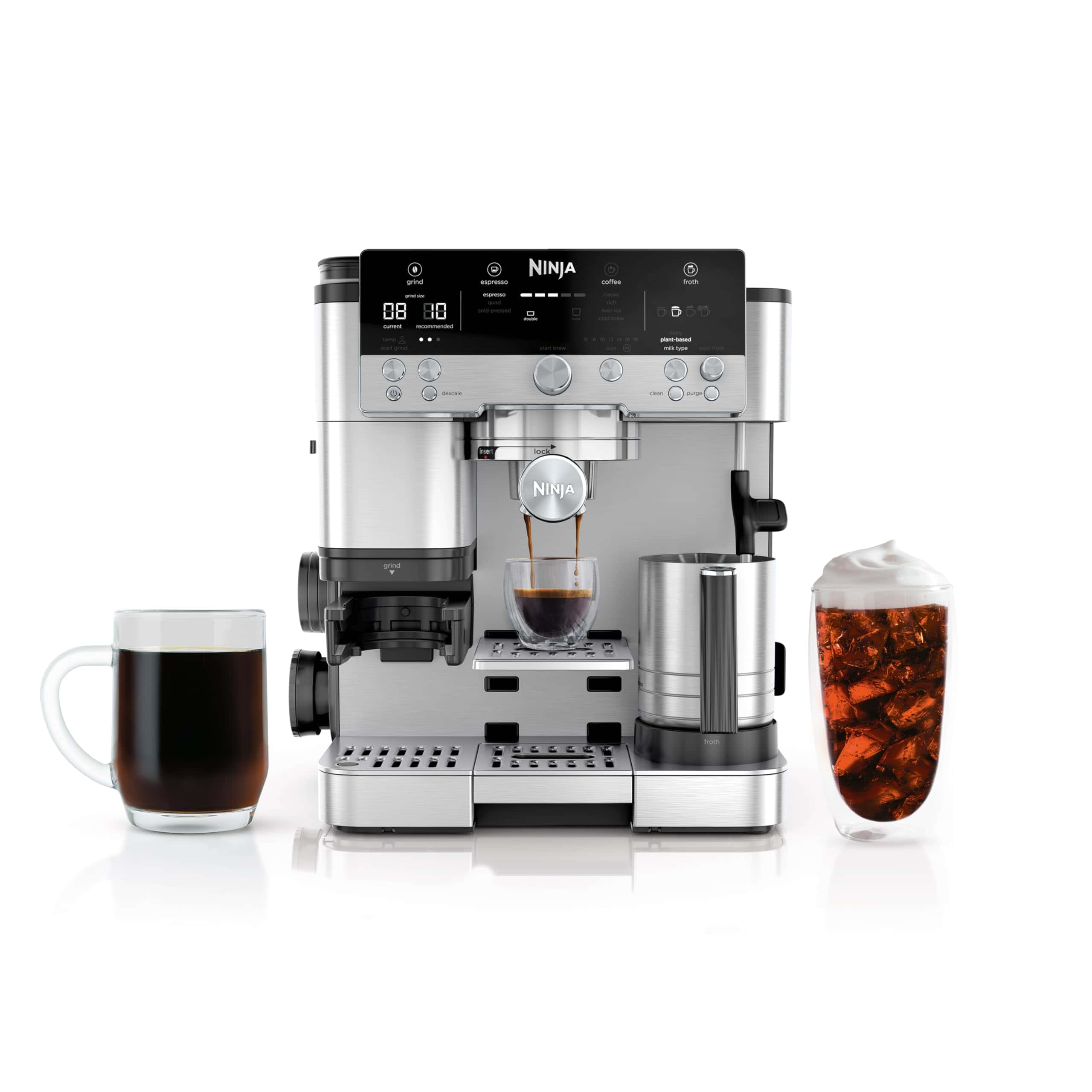
The Ninja Luxe Café Premier is worth buying for anyone who wants café-quality drinks at home without the learning curve of traditional espresso machines.
Pros
- 3-in-1 system makes espresso, drip coffee, and cold brew
- Guided experience with grind recommendations and automatic brew adjustments
- Hands-free milk frothing system works with both dairy and plant-based milks
Cons
- Takes up significant counter space
- Higher price point than basic coffee makers
- Learning all features requires some initial time investment
We tested the Ninja Luxe Café Premier for a week, and it truly simplifies the espresso-making process. The machine guides you through each step, from suggesting the right grind size to automatically adjusting temperature and pressure. This took away the guesswork that often makes home espresso intimidating.
The integrated conical burr grinder with 25 settings is a standout feature. It delivered consistent, fresh grounds for each drink we made. We especially liked the weight-based dosing system, which measures the exact amount of coffee needed rather than relying on timed grinding like other machines.
Making milk drinks was surprisingly simple. The hands-free frothing system created perfect microfoam for our lattes and cappuccinos without any manual work. We tried both regular milk and oat milk, and both frothed beautifully with the automatic system.
The cold brew function impressed us too. Instead of waiting 12-24 hours for traditional cold brew, this machine produced a smooth, rich cold brew in minutes. The cold-pressed espresso option made delicious iced drinks without the bitterness that can come from hot espresso poured over ice.
| Brewing Method | Time to Brew | Best For |
|---|---|---|
| Espresso | 30 seconds | Rich, concentrated shots |
| Drip Coffee | 2-3 minutes | Everyday drinking |
| Cold Brew | 10 minutes | Smooth, less acidic drinks |
The assisted tamper helped create perfect pucks of coffee every time, ensuring even water flow through the grounds. This consistency is key for good espresso, and the Ninja makes it nearly foolproof.
Clean-up was easier than expected. The built-in storage for accessories kept our counter tidy, and the dishwasher-safe parts simplified maintenance.
LERTIN Espresso Machine
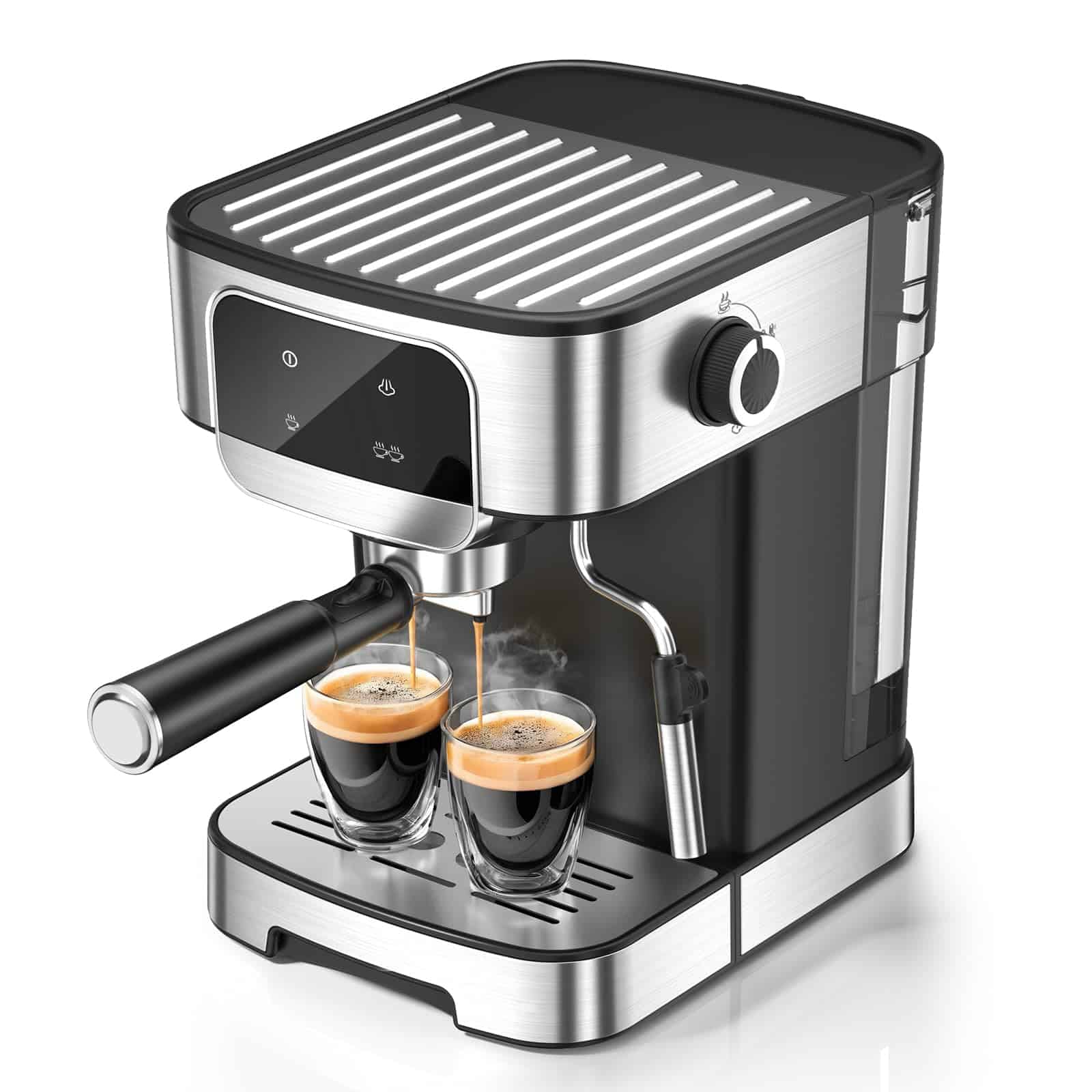
The LERTIN Espresso Machine offers excellent value for home baristas with its powerful 20-bar pressure system and convenient milk frother.
Pros
- Easy-to-use touch screen interface with clear instructions
- Powerful 20-bar pressure creates rich, flavorful espresso
- Versatile milk frother for making lattes and cappuccinos
Cons
- Machine can be somewhat noisy during operation
- Instructions could be clearer for first-time users
- Takes up moderate counter space in smaller kitchens
We recently tried the LERTIN Espresso Machine and were impressed by its performance. The stainless steel design gives it a premium look that fits well in most kitchens. When we made our first shots, the 20-bar pressure system extracted rich espresso with a nice crema layer on top.
The milk frother works surprisingly well for a machine at this price point. It created thick, creamy foam perfect for cappuccinos. We found the steam wand easy to position thanks to its 360° adjustability. The large 61-ounce water tank is a big plus too – we made several drinks without needing to refill.
Temperature control makes a real difference in espresso quality. This machine’s NTC sensor automatically adjusts water temperature during brewing. We noticed how this balanced the acidity in our coffee. The auto-shutoff feature after 20 minutes saved energy when we forgot to turn it off one morning.
Setting up our drinks was simple with the LED touch screen. The machine preheats quickly, and we liked placing our cups on top to warm them while waiting. Cleanup is straightforward since both the water tank and drip tray are removable. For the price, this espresso maker delivers cafe-quality drinks without the learning curve of more complex machines.
| Feature | Specification |
|---|---|
| Pressure | 20 Bar |
| Water Tank | 61 oz (1.8L) |
| Power | 1200W |
| Auto Shutoff | 20 minutes |
| Special Features | Milk frother, Touch screen, Cup warmer |
Atatix Espresso Machine
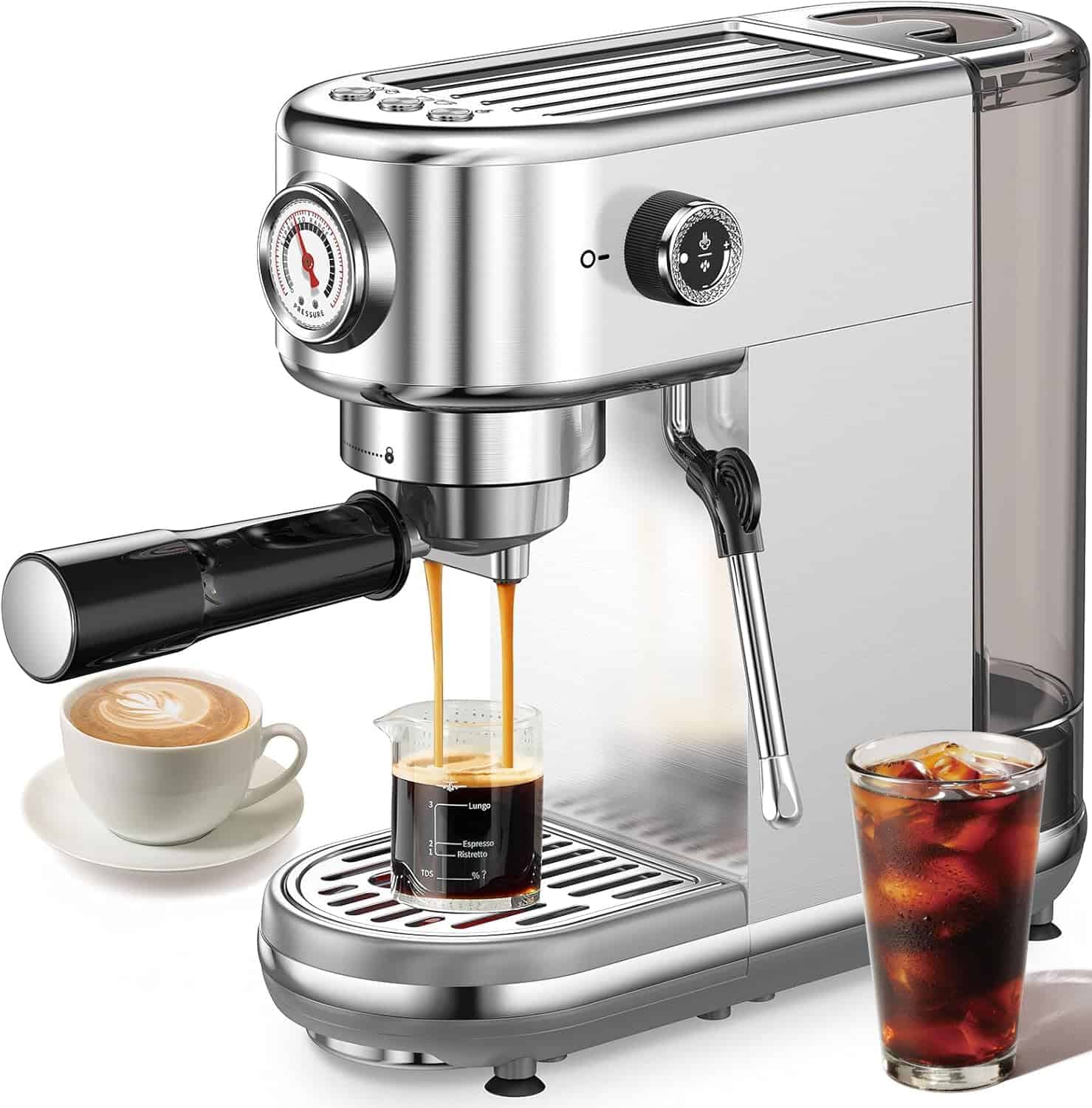
The Atatix Espresso Machine delivers café-quality drinks at home with its powerful 20-bar pressure system and versatile milk frother at a reasonable price point.
Pros
- Powerful 20-bar pressure creates rich, flavorful espresso
- Versatile milk frothing system for lattes and cappuccinos
- Customizable manual extraction option
Cons
- Learning curve for first-time espresso machine users
- Limited cup capacity for larger drinks
- Takes up counter space in smaller kitchens
We recently tested the Atatix Espresso Machine and were impressed by its performance. The 20-bar pressure system extracts maximum flavor from coffee grounds, producing rich espresso with a perfect crema layer. During our testing, each shot came out consistently hot thanks to the NTC temperature control system.
The milk frother works surprisingly well for a machine in this price range. We created velvety microfoam for lattes and cappuccinos that rivaled coffee shop quality. The steam wand has enough power to create proper texture for milk-based drinks and even simple latte art with some practice.
What sets this machine apart is its dual extraction modes. The automatic setting produces perfect single or double shots with preset timing, while the manual mode lets you control extraction time up to 102 seconds. This feature gave us flexibility to experiment with different coffee varieties and grind sizes.
The machine feels solidly built with its stainless steel and ABS construction. Four suction cups on the bottom keep it stable during operation – no wobbling when locking in the portafilter. The removable water tank and drip tray make cleaning simple, though we recommend rinsing parts after each use to prevent coffee oil buildup.
For anyone looking to make quality espresso drinks at home without breaking the bank, this Atatix machine delivers impressive results. It balances user-friendly features with enough customization to satisfy both beginners and those wanting to develop their barista skills.
Wirsh Home Barista Espresso Machine

The Wirsh Home Barista delivers impressive coffee quality and versatility at an entry-level price point that makes it worth considering for beginners.
Pros
- Powerful 20 bar pump produces excellent extraction pressure
- Compact design fits easily on countertops
- Versatile enough for multiple coffee drink styles
Cons
- Learning curve for first-time espresso machine owners
- Steam wand requires practice to master
- Water tank needs frequent refilling with heavy use
We tested the Wirsh Home Barista for two weeks, and it surprised us with its performance. The 20 bar Italian pump creates proper extraction pressure, resulting in espresso with rich crema. The machine heats up quickly thanks to its 1350W thermo-block system, so we didn’t waste time waiting around for our morning coffee.
The stainless steel design looks more expensive than its price tag suggests. We appreciated the simple control panel with just three buttons that light up to show which function is active. It’s refreshing to use a coffee machine that doesn’t require a manual every time you want to make a drink.
Making lattes and cappuccinos with the built-in steam wand took some practice. Our first attempts created more bubbles than silky microfoam, but after a few tries, we got the hang of it. The 42oz water tank is decent for a machine this size, though we found ourselves refilling it after making about 6-8 drinks.
| Feature | Details |
|---|---|
| Pressure | 20 Bar Italian pump |
| Heating | 1350W thermo-block system |
| Capacity | 42oz removable water tank |
| Included | Single/double shot filters, scoop/tamper |
| Size | 12.2″D x 5.5″W x 11.9″H |
The portafilter comes with both single and double shot baskets, letting us adjust our caffeine intake based on the day’s needs. We found the tamper works well enough, though coffee enthusiasts might want to upgrade to a heavier one for more consistent results.
Buying Guide
Choosing the right espresso machine can feel overwhelming with so many options available. We’ve created this guide to help you make the best choice for your needs and budget.
Price Range
Price is often the first consideration when buying an espresso machine. Home machines generally fall into these categories:
| Price Range | Type | Features |
|---|---|---|
| $100-300 | Entry-level | Basic functionality, limited durability |
| $300-700 | Mid-range | Better build quality, more consistent results |
| $700-1500 | Prosumer | Commercial components, long-lasting |
| $1500+ | Professional | Premium materials, advanced features |
Machine Types
Different espresso machines suit different needs. Consider how much involvement you want in the brewing process.
Manual machines give you complete control but require skill. Semi-automatic machines handle pressure but let you decide when to start and stop extraction.
Automatic machines control both pressure and timing. Super-automatic machines do everything from grinding to brewing with the push of a button.
Important Features
Look for a quality pump that can maintain 9 bars of pressure during extraction. This is essential for proper espresso.
Pay attention to the boiler system. Single boilers are more affordable but can’t brew and steam simultaneously. Dual boilers allow for both functions at once.
Size and Capacity
Measure your counter space before buying. Some professional-grade machines require significant room.
Also consider the water reservoir size. Smaller tanks mean more frequent refilling.
Additional Considerations
Check for a good warranty and available replacement parts. Quality machines should last many years with proper care.
Think about noise level if you’ll be making coffee early in the morning while others are sleeping.
Frequently Asked Questions
Many people have questions about choosing and maintaining espresso machines. Here are answers to some common questions to help you make informed decisions.
What are the essential features to look for in a home espresso machine?
When shopping for a home espresso machine, look for consistent temperature control. This ensures your espresso extracts evenly.
Pressure is another key feature. The machine should maintain 9 bars of pressure during brewing for optimal extraction.
A quality steam wand is essential if you enjoy milk drinks. Look for wands that produce fine microfoam for lattes and cappuccinos.
Water reservoir size matters for convenience. Larger tanks mean less frequent refilling, which is helpful for households with multiple coffee drinkers.
Programmable settings can save time. These allow you to set your preferred brewing parameters for consistent results.
How does machine type affect espresso quality for commercial purposes?
Commercial-grade machines typically offer greater temperature stability than home models. This consistency is crucial when serving many customers.
Multi-group heads allow baristas to prepare several drinks simultaneously. This feature is essential during rush periods.
Automatic dosing in commercial machines ensures consistent espresso quality. Even with different baristas, the shots maintain uniform taste.
Boiler size and recovery time affect workflow efficiency. Larger boilers maintain temperature better when making many drinks consecutively.
Commercial machines also include more durable components. These withstand the heavy use typical in café environments.
Which factors should I consider when choosing an espresso machine with a built-in grinder?
Grinder type is the most important factor. Burr grinders produce more consistent grounds than blade grinders, resulting in better espresso.
Grind adjustment settings should be precise. More adjustment options allow you to dial in the perfect grind size for your beans.
Bean hopper capacity affects convenience. Larger hoppers require less frequent refilling.
| Feature | Why It Matters |
|---|---|
| Grind settings | More settings = better taste control |
| Burr material | Ceramic burrs often last longer than steel |
| Grind speed | Faster grinding = less heat transfer to beans |
| Noise level | Quieter operation is better for home use |
Doser vs. doserless design affects workflow. Doserless grinders deliver grounds directly to your portafilter, minimizing waste.
What maintenance is required to keep an espresso machine in optimal condition?
Daily cleaning of the group head prevents coffee oil buildup. Simply run water through without coffee, or use a brush for more thorough cleaning.
Backflushing with cleaning detergent should be done weekly. This removes coffee residue from internal valves and pipes.
Descaling every 1-3 months removes mineral buildup. The frequency depends on your water hardness.
Steam wand purging after each use prevents milk from clogging the tip. Wipe it with a damp cloth immediately after steaming.
Filter replacement should follow manufacturer guidelines. Most need changing every 2-3 months for optimal water quality.
What distinguishes professional espresso machines from entry-level models for home use?
Build quality is the most noticeable difference. Professional machines use commercial-grade components designed for all-day operation.
Heating systems differ significantly. Professional machines often use heat exchangers or dual boilers for simultaneous brewing and steaming.
Temperature stability is superior in professional models. They maintain precise brewing temperatures even with heavy use.
Price reflects these differences. Professional machines can cost 5-10 times more than entry-level home models.
Professional machines offer greater repair potential. They’re designed to be serviced rather than replaced when parts wear out.
How does the pressure rating of an espresso machine impact the brewing process?
The standard pressure for espresso extraction is 9 bars. This pressure forces water through the coffee grounds at the ideal rate.
Too little pressure (below 8 bars) results in under-extraction. The espresso will taste weak and sour.
Excessive pressure (above 10 bars) can cause over-extraction. This produces bitter flavors and potentially damages the coffee puck.
Pre-infusion features use lower pressure initially. This gently wets the grounds before full pressure, improving extraction evenness.
Pressure profiling, available on advanced machines, allows pressure adjustment during brewing. This can enhance different flavor notes in specialty coffees.





